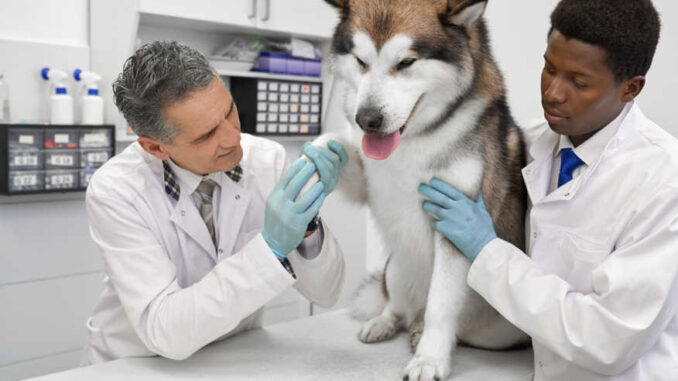
This article was updated on June 8th, 2023

Dog paw infections are one of the more common issues that we treat in our veterinary hospital: dogs often excessively lick their paws when they feel itchy or uncomfortable, which can lead to skin infections. In this article, our veterinarians share pictures and tips about the most common paw infections and issues in dogs.
If your dog has a bump or a lump on their paws, you can read our article: Lumps Often Found on Paws.
7 Common Dog Paw Infections & Issues [With Pictures]
You will find below the most common types of paw issues, along with pictures. Note that many of these conditions are challenging to distinguish based on visual appearance alone, and you will likely need a veterinary exam to determine the underlying cause. Let’s take a look:
1. Inflammation (Allergic Pododermatitis)
Pododermatitis in dogs is a condition that affects the paw pads and skin on the feet, resulting in redness and swelling between the toes and all over the paw, as shown in the picture below:
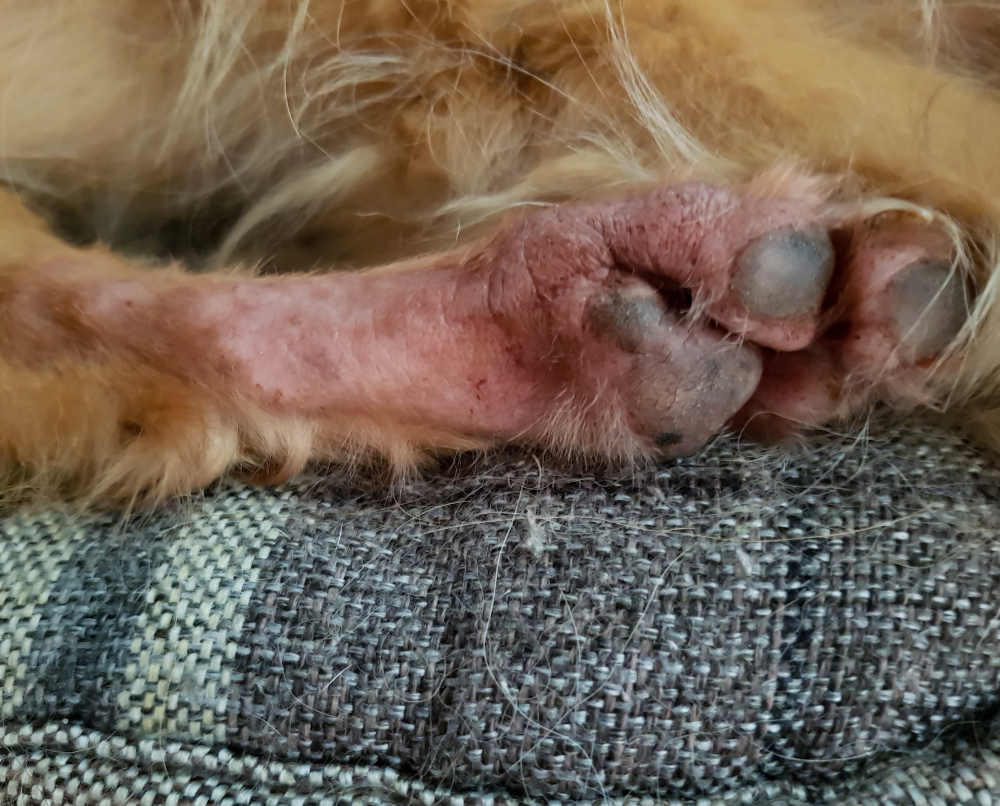
In many cases, the paws are damp due to licking and chewing. The inflammation can be caused by a variety of factors, including:
- allergies (very common cause): all four paws are often affected, although it’s possible to have only one or two paws affected.
- bacterial or fungal infections,
- foreign bodies, and
- trauma to the paw pads.
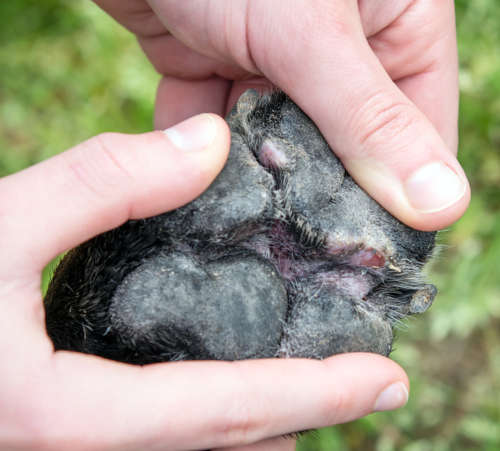
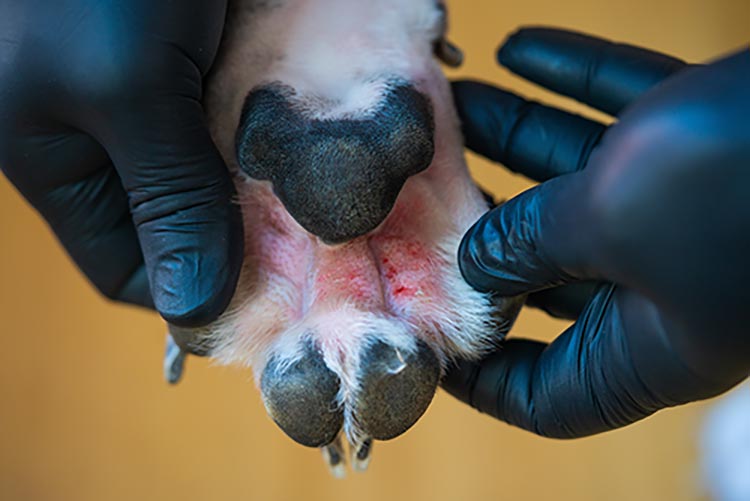
How it is treated: Allergies can usually be managed with medication, but they are never fully cured. Your dog will likely require lifelong treatment with oral, injectable, or topical allergy medications, as well as lifestyle changes to reduce their exposure to allergens. If you suspect that your dog may have allergic pododermatitis, seek veterinary care to discuss an appropriate treatment plan and rule out secondary infections.
Learn more about paw allergy issues.
2. Bacterial Infection
A bacterial infection can occur as an isolated condition, or it can develop as a result of allergic pododermatitis or other skin diseases. Symptoms of bacterial infections may appear to be the same as symptoms of allergic pododermatitis (including redness and swelling). In some cases, however, dogs may develop pus and draining tracts as a result of the infection, as shown in the picture below.
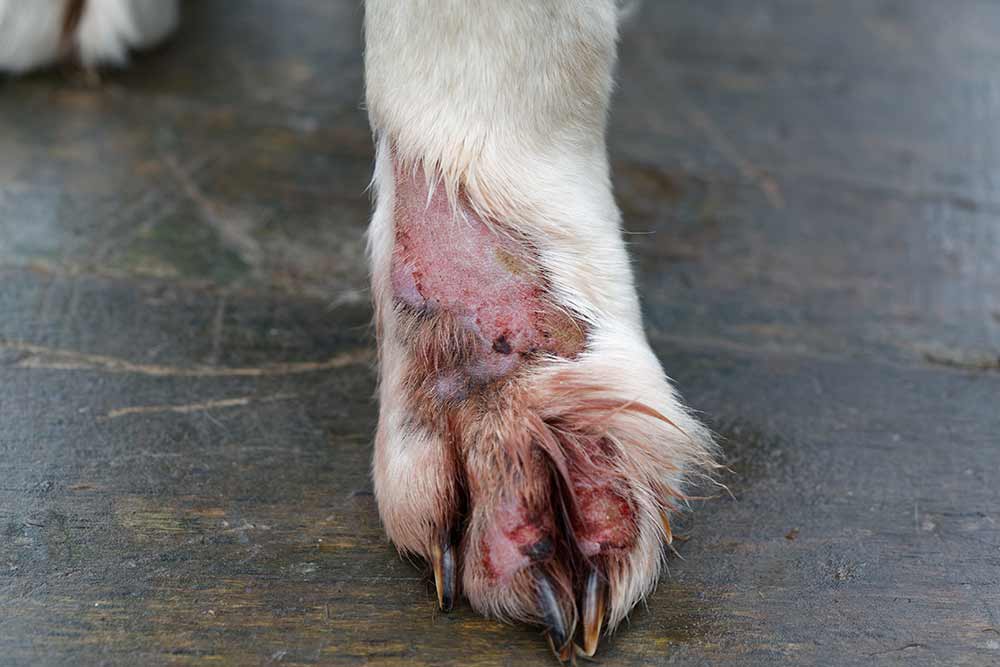
Treatment for bacterial infections: Bacterial infections of the paws can vary in severity, but most cases can be treated with several weeks of oral antibiotics. If you suspect that your dog may have a bacterial infection, prompt veterinary care is essential in order to allow a speedy resolution with treatment. The cost of antibiotics will depend on your dog’s size and the duration of antibiotic therapy that is needed, but most cases can be treated for less than $300.
3. Yeast Infection
Although your dog’s skin always contains a small amount of yeast on its surface, a yeast infection occurs when these yeast begin to proliferate unchecked. Yeast infections on dog paws typically exhibit symptoms like redness, itching, swelling, and a foul odor. Dogs may also lick or chew their paws excessively.
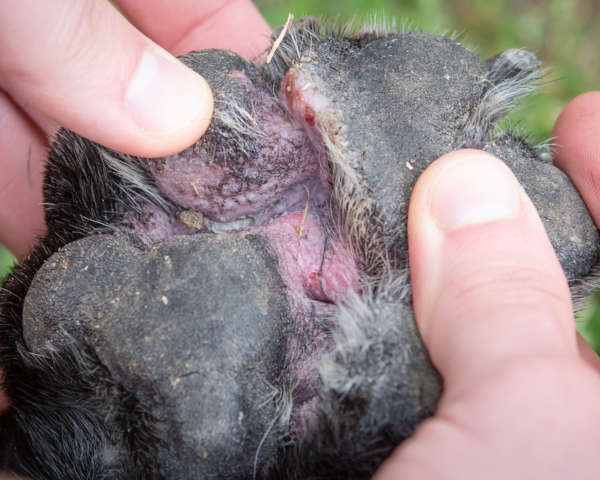
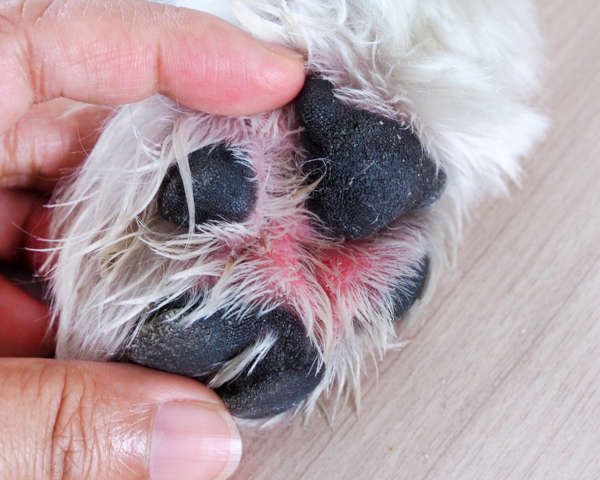
In many cases, a yeast infection of the paws is clinically indistinguishable from a bacterial infection or allergic dermatitis. Therefore, your veterinarian will perform diagnostic tests to determine the cause of your dog’s paw infection.
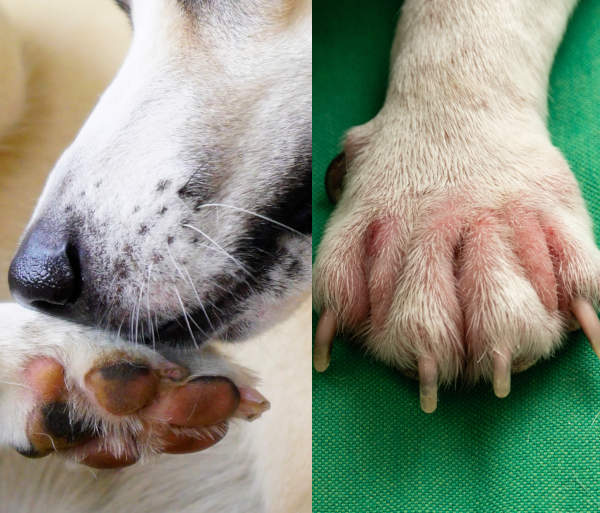
Treatment for yeast infections: Once diagnosed, a yeast infection is typically treated with a combination of oral and topical antifungal medications. The cost of treatment may vary, depending on your dog’s size and the severity of the infection, but many cases can be treated for less than $300. Learn more about paw yeast infections in dogs.
“If your dog is frequently licking or chewing their paws, or if you notice redness and swelling, it could be a sign of paw inflammation or infection. It’s important to take your pet to the vet as soon as possible to get it checked out. Even mild paw infections should be treated within a few days: delayed treatment can make the situation worse and more difficult to treat. “
4. Ingrown Toenail
When a dog’s toenails become excessively long, they can curl all the way around and begin to grow into the skin. This is more likely to occur on the dewclaws because they do not have pressure from the ground to slow their growth. An ingrown toenail can be identified by the presence of a long, curled toenail, often with irritation or pus visible at the site where the nail is putting pressure on the skin.
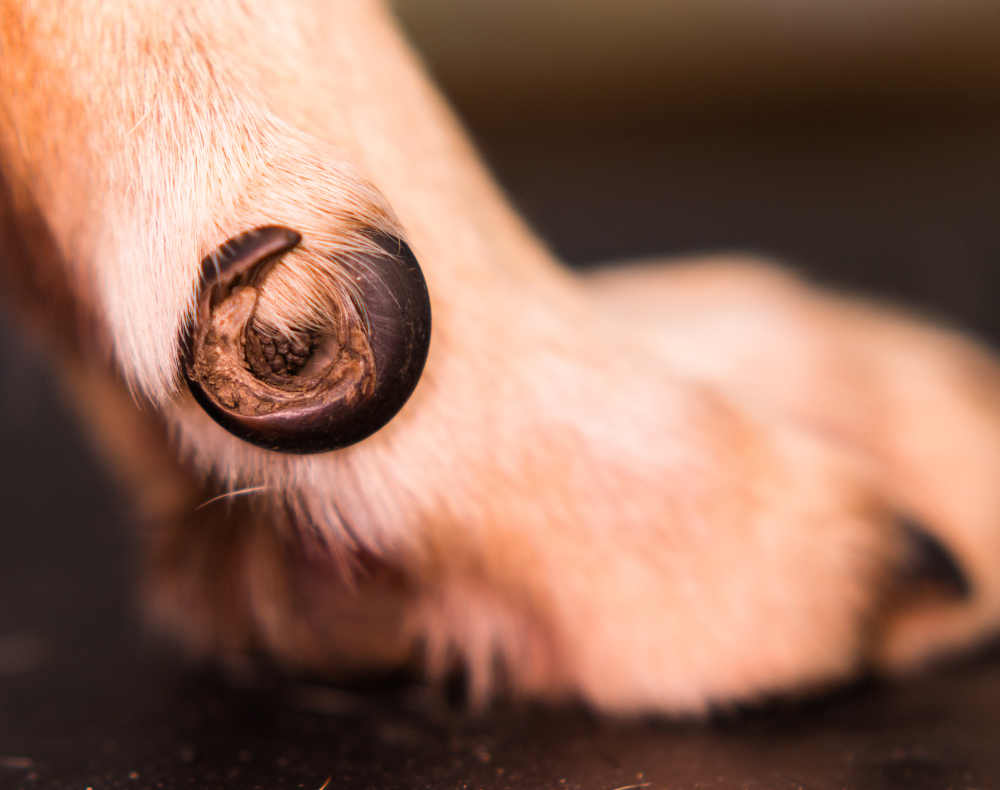
How it is treated: Your veterinarian will treat this condition by trimming the overgrown toenail, then prescribing oral antibiotics to treat the infection. In many cases, your dog may also receive additional medications to treat pain and inflammation. Treatment typically costs less than $100, although costs may be higher if your dog must be sedated to permit a nail trim.
5. Toenail Trauma
Broken toenails are relatively common injuries in dogs. Unfortunately, a broken toenail can lead a dog to lick or chew at their paw excessively, contributing to an infection. In addition to redness and inflammation, you will likely be able to see the torn or damaged toenail.
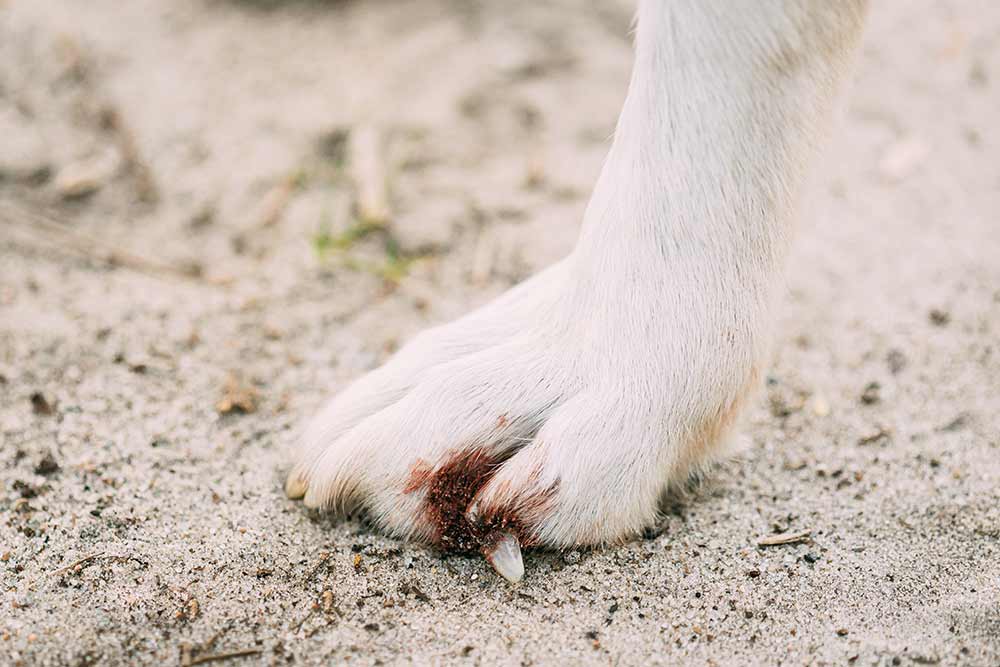
How it is treated: Your veterinarian will treat this by trimming the broken nail, bandaging the foot (if needed), and prescribing a combination of pain medication and antibiotics. This treatment typically costs less than $150, although costs may be higher if your dog requires sedation.
6. Penetrating Foreign Body or Wound
Dogs get their paws everywhere! A foreign object, such as a stick, sandspur, or foxtail (grass awn), can lead to significant infection and inflammation of the paw. In addition to generalized swelling and redness, you may be able to see a foreign object or a visible wound where it punctured the skin. Below is a picture of grass seeds stuck in the skin, with redness surrounding the area:
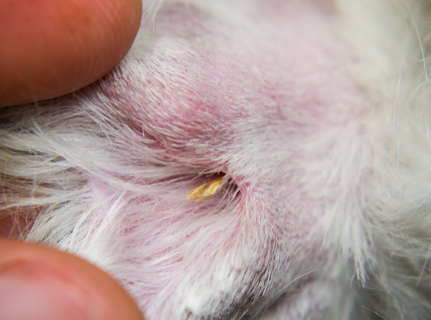
Grass seeds and other foreign objects can cause paw injuries. The picture below shows a circular skin lesion that is furless and the skin is red, inflamed and broken in some places. Some of the surrounding fur is ‘saliva stained’ due to excessive licking:
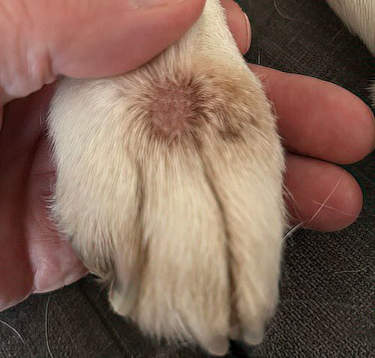
Below is a more severe case of a wound resulting from a foreign body:
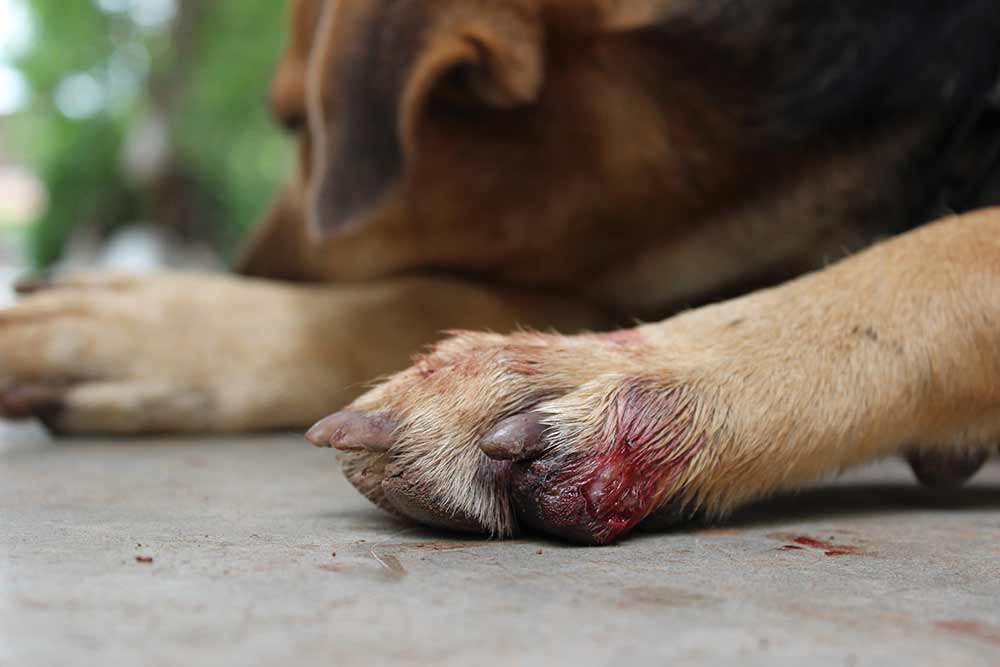
How it is treated: Treatment options vary, depending on whether the foreign object is still present and requires surgical extraction under anesthesia or whether your dog can be treated with simple antibiotics. Treatment costs may vary from $50-500, depending on the care that your dog needs.
7. Pad Injury
Any injury to your dog’s paw pads can contribute to an infection, by causing discomfort and leading your dog to lick excessively at the paws. Pad injuries can be caused by long walks on rough pavement, standing on an especially hot surface, or walking on sharp rocks. In most cases, you will be able to see visible damage to the surface of your dog’s paw pads.
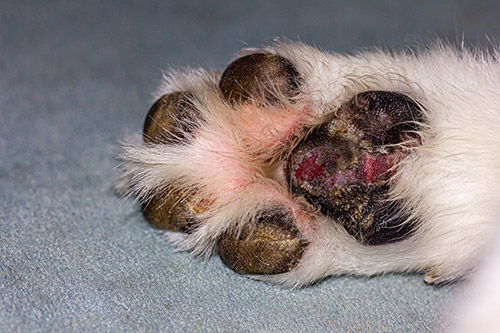
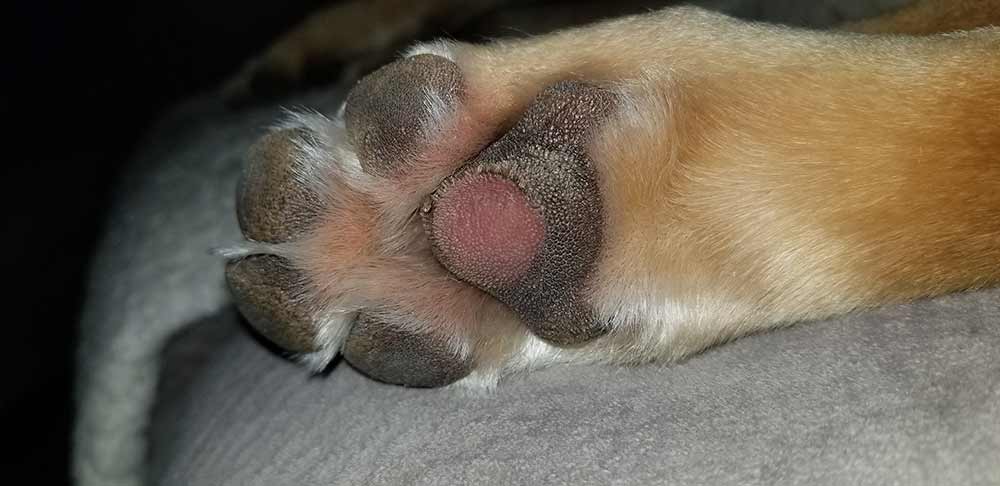
How it is treated: A pad injury should always be evaluated by a veterinarian. Your veterinarian may recommend bandaging the paw, and your dog will likely be treated with pain medication and antibiotics. In some cases, pad injuries can be repaired with surgery. Costs may range from $50-500, depending on the level of care that your dog requires.
Signs of a Serious Paw Problem: When Your Vet is Needed ASAP
Signs that your dog should see a veterinarian include:
- Redness
- Swollen paws
- Limping or reluctance to walk
- Excessive licking or chewing of the paws
- Bleeding
If your dog appears especially uncomfortable, or you notice significant bleeding, you should ensure that your dog receives care as soon as possible. Even mild paw infections should be treated within a few days, because postponing treatment can allow the problem to worsen and make treatment more challenging.
For example, significant paw inflammation (as seen below) requires a veterinary visit as soon as possible:

3 Tips to Help Your Dog At Home
If your dog’s paws are inflamed or infected, there are a few things that you can do to keep your dog comfortable until your veterinary visit.
1. Clean your dog paws
First, begin by cleaning your dog’s paws thoroughly. If your dog has stepped into some sort of irritating substance, a thorough cleaning may be enough to remove the offending substance and help alleviate some of the inflammation.
2. Prevent excessive licking
Next, prevent your dog from licking at their paws excessively. Inflamed paws itch, which triggers your dog to lick at the paws. Unfortunately, licking at the paws will cause more irritation and can create a moist environment that promotes infection. Therefore, you need to keep your dog from licking at the paws. An e-collar or cone can be used to block your dog’s ability to access their paws. You can also read our article on how to stop dogs from licking their wounds.
3. Avoid activities that may irritate your dog’s paws
Finally, avoid activities that will irritate your dog’s paws further. Long walks on hot pavement and walking on rocky or rough surfaces could exacerbate your dog’s paw irritation. It’s best to keep your dog on smooth, soft, non-irritating surfaces, at least until you’re able to have your dog evaluated by a veterinarian.
Dog Paw Infections: Causes & Prevention
Paw infections can have a wide variety of potential causes:
1. Allergies
One of the most common causes of paw infections and inflammation is underlying allergies. Just like their human owners, many dogs are allergic to tree pollen, weeds, and grasses. Unlike humans, however, dogs are more likely to develop itchy skin than a runny nose and watery eyes. In many cases, allergic skin disease shows up on the paws. Preventing these infections due to allergies will require managing your dog’s underlying allergies. Work with your veterinarian to find a treatment protocol that works for your dog, realizing that your dog will likely require lifelong care. Learn more about paw issues caused by allergies.
2. Poor hygiene
Proper hygiene and grooming can also help reduce the risk of infections. Some infections occur due to broken or ingrown toenails. Additionally, matted fur may trap moisture and debris close to the skin, putting your dog at greater risk of a skin infection. Keeping the fur on your dog’s paws trimmed, and the nails at an appropriate length can reduce the risk of skin infections.
3. Environmental hazards
Paw infections can also be caused by environmental hazards. For example, sand spurs and foxtails (grass awns) may contribute to paw infections in some areas of the country. If your dog is prone to these sorts of infections, work with your veterinarian to identify high-risk environments and limit your dog’s access to these areas. If your dog must walk in areas that are rough or treacherous, you may want to consider using booties to protect your dog’s paws.
Skin scraping, fungal culture and other tests may be needed to diagnose your dog’s problem
Your veterinarian will begin with a thorough physical exam and likely recommend a number of diagnostic tests. Common tests that may be recommended for a dog with an infection include:
- Skin scraping: Your veterinarian will run an oil-coated scalpel blade across the surface of your dog’s skin, then examine the collected sample under low power on a microscope. This test looks for mites that can live on the surface of the skin (scabies) or within the hair follicles (Demodex).
- Fungal culture: Your veterinarian will obtain hair samples from your dog’s paws, place them on a petri dish containing fungal growth medium, and incubate the samples to assess for fungal growth. This test is used to test for ringworm.
- Skin cytology: Your veterinarian will collect a sample from the surface of your dog’s skin, stain the sample, and examine it under a high-powered microscope. This allows the diagnosis of bacterial and yeast infections.
Veterinary treatments
Depending on the results of your dog’s diagnostic tests, your veterinarian will prescribe appropriate treatments for your dog’s paw condition. In many cases, these infections are treated with:
- Oral antibiotics and/or
- Antifungals
- Your veterinarian may also recommend topical treatments, such as ointments, medicated powders, or medicated shampoos.
- Additionally, your veterinarian may recommend the use of an e-collar to prevent your dog from licking and chewing at their paws.
Less commonly, treatments such as surgical wound exploration, bandaging of the paw, or other measures may be recommended.
5 Tips for Healthy Paws
- Keep your dog’s nails trimmed to an appropriate length.
- Carefully trim excess fur (if you have a long-haired dog), to prevent matting and reduce the number of foreign objects that may become trapped in your dog’s hair.
- Check your dog’s paws daily, looking for wounds, toenail injuries, and inflammation.
- Pay attention to your dog’s routine behavior, looking for excessive licking at the paws that may indicate an infection.
- Contact your veterinarian if you notice any problems or changes in your dog’s paws.
Related posts:
 Dog Paw Allergy Issues: 6 Tips to Help Your Dog [With Pictures] - One of my pet parents brought her dog into the clinic because he was furiously licking and chewing on his… [...]
Dog Paw Allergy Issues: 6 Tips to Help Your Dog [With Pictures] - One of my pet parents brought her dog into the clinic because he was furiously licking and chewing on his… [...]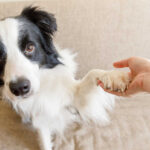 White Bumps on a Dog’s Paw: Most Likely Reasons - If you’ve noticed a new white bump or lump on your dog’s paw you’re probably wondering what’s causing it. White… [...]
White Bumps on a Dog’s Paw: Most Likely Reasons - If you’ve noticed a new white bump or lump on your dog’s paw you’re probably wondering what’s causing it. White… [...] 4 Cysts Often Found on Dog Paws [With Pictures & Vet Advice] - Ahh dog feet, giant Great Dane Marmaduke paws, tiny terrier tootsies, the puffy, fluffy white feet of a Bichon Frisé.… [...]
4 Cysts Often Found on Dog Paws [With Pictures & Vet Advice] - Ahh dog feet, giant Great Dane Marmaduke paws, tiny terrier tootsies, the puffy, fluffy white feet of a Bichon Frisé.… [...] Paw Yeast Infections in Dogs: What They Look Like & What To Do - When most people think of yeast, the first thing to come to mind would probably be a freshly baked loaf… [...]
Paw Yeast Infections in Dogs: What They Look Like & What To Do - When most people think of yeast, the first thing to come to mind would probably be a freshly baked loaf… [...]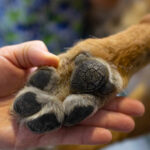 Paw Problems: 8 Common Lumps on Dog Paws [16 Pictures] - Seeing skin issues is a nearly everyday thing at our veterinary clinic. This article will help you identify lumps, bumps,… [...]
Paw Problems: 8 Common Lumps on Dog Paws [16 Pictures] - Seeing skin issues is a nearly everyday thing at our veterinary clinic. This article will help you identify lumps, bumps,… [...] Dog with Cracked Paws? Our Veterinarian Explains What to Do - A dog’s feet often seem indestructible. After all, they’re on the go in all types of terrain, allowing your dog… [...]
Dog with Cracked Paws? Our Veterinarian Explains What to Do - A dog’s feet often seem indestructible. After all, they’re on the go in all types of terrain, allowing your dog… [...]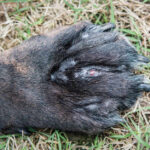 Dog with Swollen Paws [with Pictures] Our Veterinarian Explains What to Do - A dog with swollen paws or paw pads may be suffering from something as simple as a thorn in their… [...]
Dog with Swollen Paws [with Pictures] Our Veterinarian Explains What to Do - A dog with swollen paws or paw pads may be suffering from something as simple as a thorn in their… [...]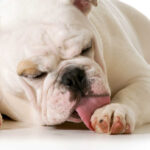 Why Is My Dog Constantly Licking His Paws? Veterinarian Advice - You may notice your dog licking his paws on occasion. This is often just part of his everyday grooming routine;… [...]
Why Is My Dog Constantly Licking His Paws? Veterinarian Advice - You may notice your dog licking his paws on occasion. This is often just part of his everyday grooming routine;… [...]Disclaimer: This website's content is not a substitute for veterinary care. Always consult with your veterinarian for healthcare decisions. Read More.

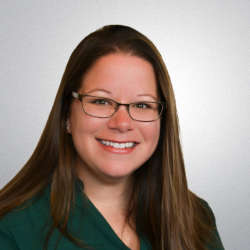




Be the first to comment